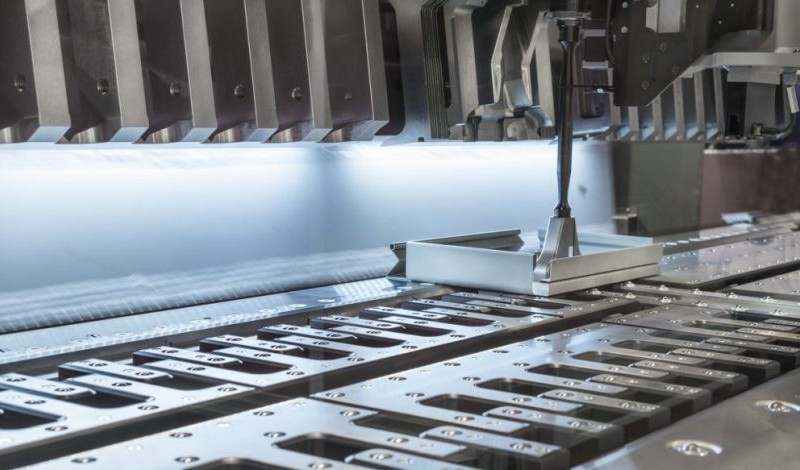Metal Stamping: Innovations Driving Industry Development
Metal Stamping: Innovations Driving Industry Development
Blog Article
Metal Marking Innovations: Elevating Manufacturing Processes for Superior Results
In the world of making procedures, steel marking has actually long been a keystone method for creating a selection of precision elements. With the unrelenting march of technological development, the landscape of metal stamping is going through a significant makeover.
Advancement of Steel Marking Methods

Furthermore, advancements in material science have actually led to the advancement of high-strength alloys that can currently be perfectly marked into detailed shapes, providing to a more comprehensive range of commercial applications. The assimilation of robotics and synthetic intelligence has further maximized the marking process by boosting rate and precision while reducing the risk of human mistake.

Impact of Advanced Materials
Have advanced materials transformed steel marking processes considerably in the manufacturing sector? The answer is a resounding yes (Metal Stamping). The integration of innovative materials has actually transformed metal stamping, making it possible for makers to attain higher accuracy, raised effectiveness, and enhanced item high quality. By using materials such as high-strength alloys, advanced compounds, and innovative finishes, metal marking processes can now create components that are lighter, stronger, and extra sturdy than ever in the past.
These sophisticated products offer premium mechanical residential or commercial properties, rust resistance, and thermal security, permitting suppliers to meet the demands of modern markets such as aerospace, automotive, and electronics. Furthermore, making use of sophisticated materials in metal stamping has helped with the manufacturing of intricate geometries and complex layouts that were previously unattainable through standard techniques.
Moreover, the execution of innovative materials has resulted in decreased material waste, lower manufacturing costs, and shorter lead times, making metal stamping processes more cost-effective and lasting. As technology proceeds to breakthrough, the influence of sophisticated products on metal stamping processes is anticipated to drive additional technology and improve the competition of manufacturers in the worldwide market.
Automation in Metal Stamping
The evolution of metal stamping processes driven by the assimilation of innovative materials has established the stage for considerable improvements in automation within the manufacturing industry. Automation in steel stamping has revolutionized manufacturing procedures, enhancing effectiveness, precision, and total output high quality. With the utilization of robotics, sensing units, and computer-controlled systems, tasks that were once hand-operated and time-consuming can currently be carried out with unrivaled speed and precision.
Automation in metal marking not only increases manufacturing prices but likewise makes sure consistency in the production process. By decreasing human intervention, the threat of errors is substantially reduced, causing higher levels of item uniformity and integrity. Furthermore, automation makes it possible for makers to undertake intricate stamping tasks that would be tough or unwise to attain manually.
Additionally, automation in metal stamping adds to a much safer working setting by decreasing the need for employees to participate in dangerous or repeated jobs - Metal Stamping. This shift in the direction of automation not only boosts productivity however likewise his explanation leads the means for the future of manufacturing, where modern technology plays a central function in driving functional quality
Quality Assurance and Examination Solutions
With an emphasis on accuracy and reliability, quality assurance and evaluation systems play a crucial function in guaranteeing item quality in steel marking procedures. These systems are made to monitor every phase of production, from product inspection to the end product, to guarantee that all components fulfill the called for criteria. By implementing advanced innovations such as optical assessment systems, coordinate measuring devices (CMM), and automated assessing devices, makers can find also the smallest deviations in dimensions, surface area top quality, and total stability of stamped parts.

Sustainability Practices in Metal Stamping
Structure upon the structure of accuracy and dependability established through quality control and examination systems, the assimilation of sustainable practices in metal marking procedures is increasingly becoming a centerpiece for makers looking for to minimize environmental effect and enhance resource usage. Sustainability practices in steel marking encompass a variety of efforts targeted at minimizing waste generation, power intake, and greenhouse gas emissions throughout the production process.
One key facet of sustainability in metal marking is the adoption of environment-friendly products and modern technologies that advertise recyclability and waste reduction. By utilizing recycled products and executing energy-efficient equipment, suppliers can reduce their carbon impact and add to a much more sustainable manufacturing cycle. Furthermore, optimizing manufacturing processes to reduce product waste and energy use not only profits the environment however additionally causes cost savings for businesses in the future.
Furthermore, the implementation of sustainable methods in metal stamping can boost brand credibility and interest ecologically aware consumers. As sustainability proceeds to gain significance in the production market, integrating useful link environmentally friendly efforts right into metal stamping procedures is necessary for long-term success and competition on the market.
Verdict
In conclusion, metal marking methods have considerably progressed over time, incorporating innovative products and automation to improve manufacturing processes. Quality control and examination systems play an important duty in guaranteeing superior outcomes, while sustainability techniques are increasingly being carried out to reduce environmental influence. These technologies check in metal stamping have transformed the market, causing extra lasting and reliable production approaches for different markets.
Steel stamping, when a manual and labor-intensive process, has changed into an extremely automated and advanced approach of shaping metal sheets right into numerous types and styles.Have sophisticated materials changed steel marking processes substantially in the production market? By utilizing materials such as high-strength alloys, advanced composites, and ingenious finishes, metal stamping procedures can currently generate parts that are lighter, more powerful, and a lot more long lasting than ever previously.
The evolution of metal marking processes driven by the assimilation of advanced materials has established the phase for significant developments in automation within the manufacturing industry.In final thought, metal stamping techniques have actually significantly advanced over time, incorporating innovative products and automation to improve making processes.
Report this page